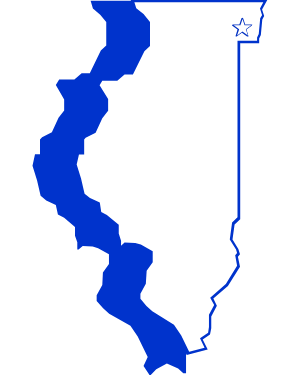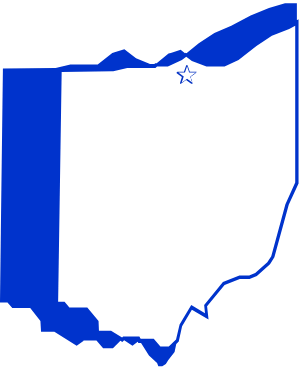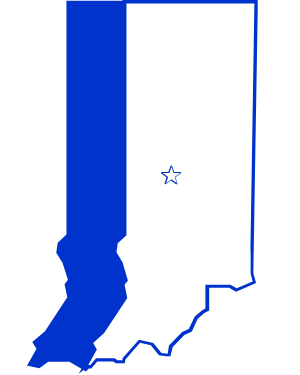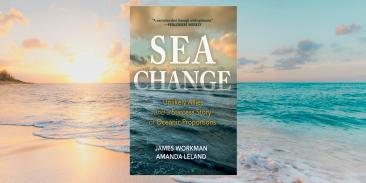Top 10 cities with the most lead pipes
EDF identified 10 cities in the U.S. with the most lead service lines (LSLs) based on numbers reported in 2021. These cities collectively have over one million LSLs, representing 12% of the 9.2 million EPA estimates are in the country.
If we are to make significant progress toward reaching the White House’s goal of eliminating LSLs, utilities in these cities must deliver results.
Below we rank each city from the most LSLs to fewest, and briefly describe the efforts each city has made toward LSL replacement. Some have robust programs, while others have yet to start addressing the problem.
1. Chicago, IL

- Chicago Department of Water Management reported 387,095 LSLs in 2021, more than twice as many as any other city. Three-quarters of its service lines are LSLs, and virtually all the rest are of unknown material.
- City ordinance actually mandated that LSLs be installed until the federal government banned them in 1986.
- Decades later, Chicago has just a small LSL replacement program and is struggling to pull itself out of a deep hole relative to most other large cities that took earlier action against lead pipes. The Chicago 2023 Mayoral Transition Report (PDF) set a goal to replace 40,000 lead service lines over the next four years. Under Illinois law, Chicago has until 2077 to replace all their LSLs.
- The City received a $336 million loan from EPA in 2020 and $8 million in state revolving funds (SRF) from Illinois EPA in 2023 to accelerate the effort, but they are still trailing behind the Mayor's goal.
2. Cleveland, OH

- Cleveland Water reported 185,409 LSLs in 2021, representing roughly 43% of all its service lines.
- The utility has a modest LSL replacement program that aims to replace 6,000 lines per year. At this rate, it would take 25 years to replace all their LSLs.
- To support the effort, Cleveland was granted more than $39 million in federal infrastructure funding from Ohio EPA in late 2023.
3. New York, NY

- New York City reported 137,542 LSLs in 2021 and an additional 230,870 lines that are of unknown material. About 43% of the city's service lines are lead or of unknown material.
- The utility has a small LSL replacement program and was awarded $48 million out of the requested $96 million in federal infrastructure funding from the State in 2024 to accelerate the effort.
4. Detroit, MI

- Detroit Water and Sewerage Department reported 79,617 LSLs in 2021 and an additional 28,922 lines that are of unknown material. About one-third of its service lines are lead or of unknown material.
- With support from the Detroit mayor and funding from the State and EPA, the utility has an excellent LSL replacement program that was designed to replace 5,000 lines in 2023 and ramp up to 10,000 per year starting in 2024.
5. Milwaukee, WI

- Milwaukee Water Works reported 74,099 LSLs in 2021, about 45% of its service lines.
- The utility has embraced the EPA's proposed 10 year replacement goal, which is reflected in their robust LSL replacement program that replaced 1,200 LSLs in 2023 and aims to ramp up to 3,000 replacements annually by 2025. Their website states they are working towards replacing a current total of roughly 65,000 lead pipes, of which they have already replaced 10%.
- They are set to receive $30 million in federal infrastructure funding from Wisconsin DNR in to accelerate the effort.
6. Denver, CO

- Denver Water reported 63,955 LSLs in 2021 and an additional 8,791 service lines that are of unknown material. About one-quarter of its service lines are lead or of unknown material.
- The utility has a model LSL replacement program that replaced 6,891 lines in 2023, ramping up to nearly 8,000 per year in 2024 with support from $76 million in federal funding.
7. St. Louis, MO

- St. Louis Water reported 63,000 LSLs in 2021. About half of its service lines are lead.
- The utility applied for $400,000 from Missouri's SRF program for inventories and an additional $5.05 million for replacement plans and projects in 2024, which qualifies as a grant under Missouri's disadvantaged community definition.
- The city does not appear to have an active LSL replacement program, so we will continue to monitor how they will use any received funding.
8. Indianapolis, IN

- Citizens Energy Group reported 55,060 LSLs in 2021 and an additional 20,000 lines that are of unknown material. About 20% of the city's service lines are lead or of unknown material.
- The utility currently has a modest LSL replacement program and requested $95.7 million in federal infrastructure funding from Indiana Finance Authority in 2023 to replace LSLs in disadvantaged communities and is seeking additional funding to accelerate the effort. Citizens was awarded $11 million in federal funding in late 2023.
9. Minneapolis, MN

- Minneapolis reported 48,502 LSLs in 2021 and an additional 3,906 lines that are of unknown material. About half of the city's service lines are lead or of unknown material.
- Very little information is available about an LSL replacement program aside from a public map of LSLs.
- The utility is seeking almost $49 million in federal infrastructure funding from Minnesota Public Facilities Authority in 2024 to accelerate the effort. It is expected to receive a significant share of the $240 million in state funding over the next ten years to remove lead pipes.
10. Cincinnati, OH

- Greater Cincinnati Water Works reported 40,214 LSLs in 2021 and an additional 2,863 that are of unknown material. About 18% of its service lines are lead or of unknown material.
- The utility has a model LSL replacement program that aims to replace about 1,500 lines a year.
About the data
The LSL estimates are based on 2021 utility responses to EPA’s 7th Drinking Water Infrastructure Needs Survey and Assessment (DWINSA) on service line material information made available in response to a FOIA request by NRDC. As New York City did not respond to EPA’s survey, data was exported from NYC OpenData’s LSL Location Coordinates on July 7, 2021.
The 7th DWINSA is currently undergoing a one-time update, and water utilities across the country are inventorying their LSLs due in October 2024 as mandated by the Lead and Copper Rule Revisions. Since 2021, estimates of LSLs may have changed in some cities as more lines are discovered through the inventorying process, while other cities – like Denver and Cincinnati – likely have fewer LSLs today as they’ve made progress towards their replacement. As more data becomes available, EDF will update the relevant LSL estimates.
Explore EDF’s map to learn more about LSL replacement programs across the country
This webpage is adapted and updated from a 2023 EDF blog post










